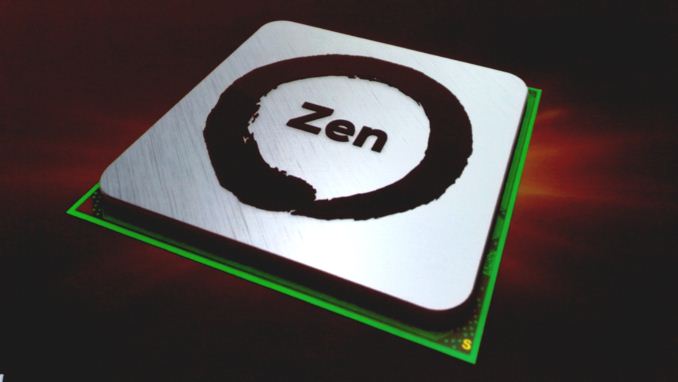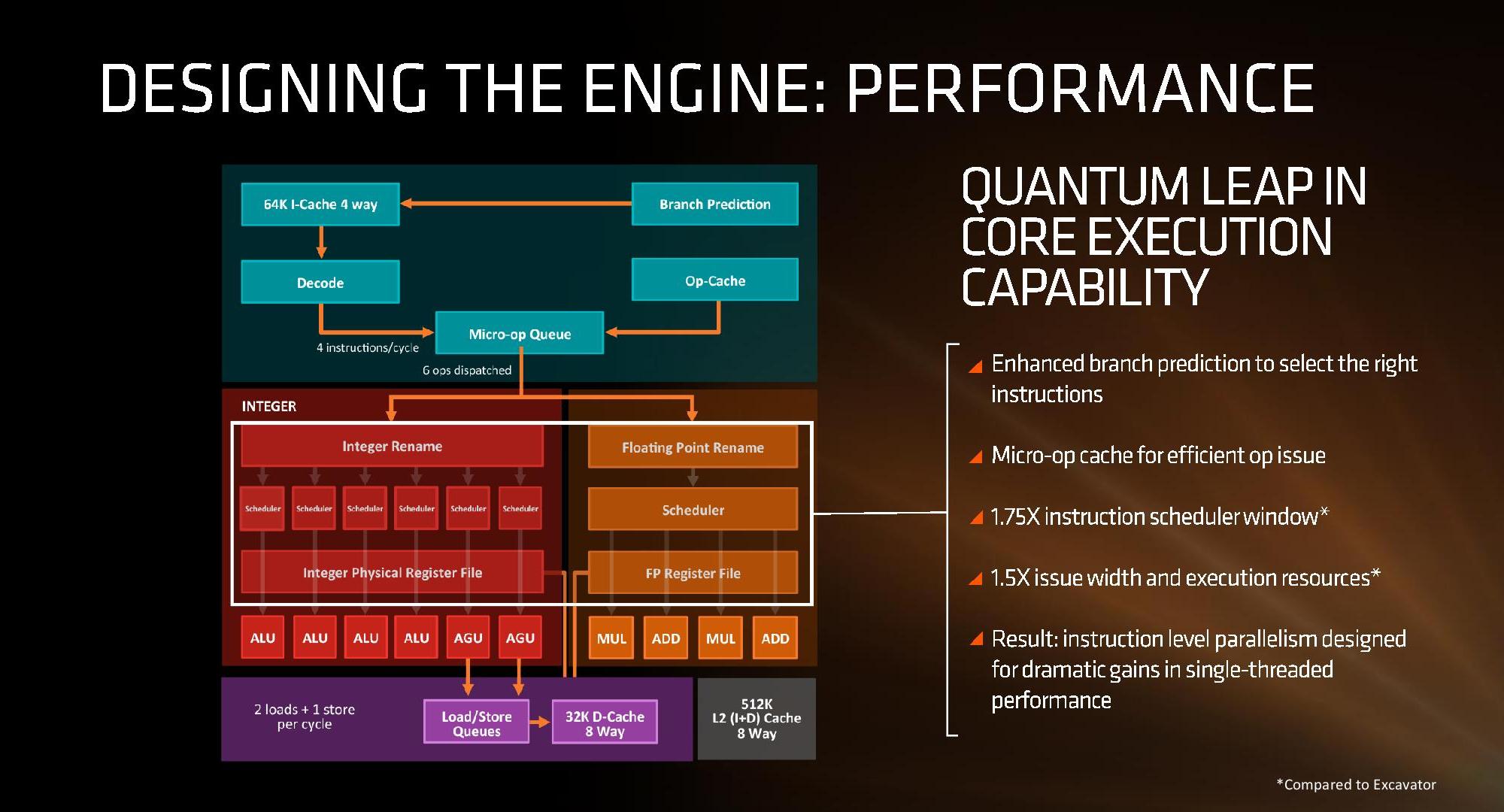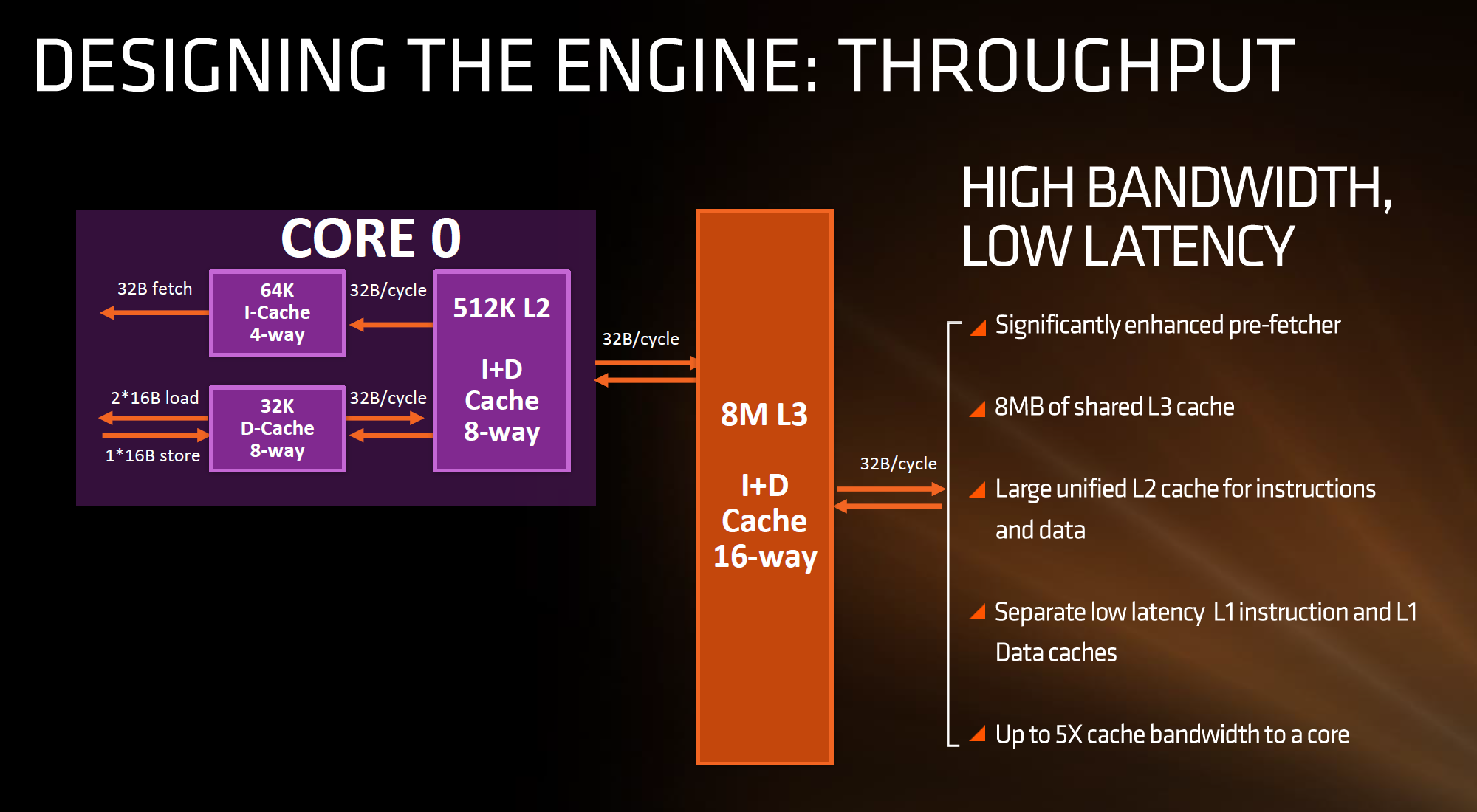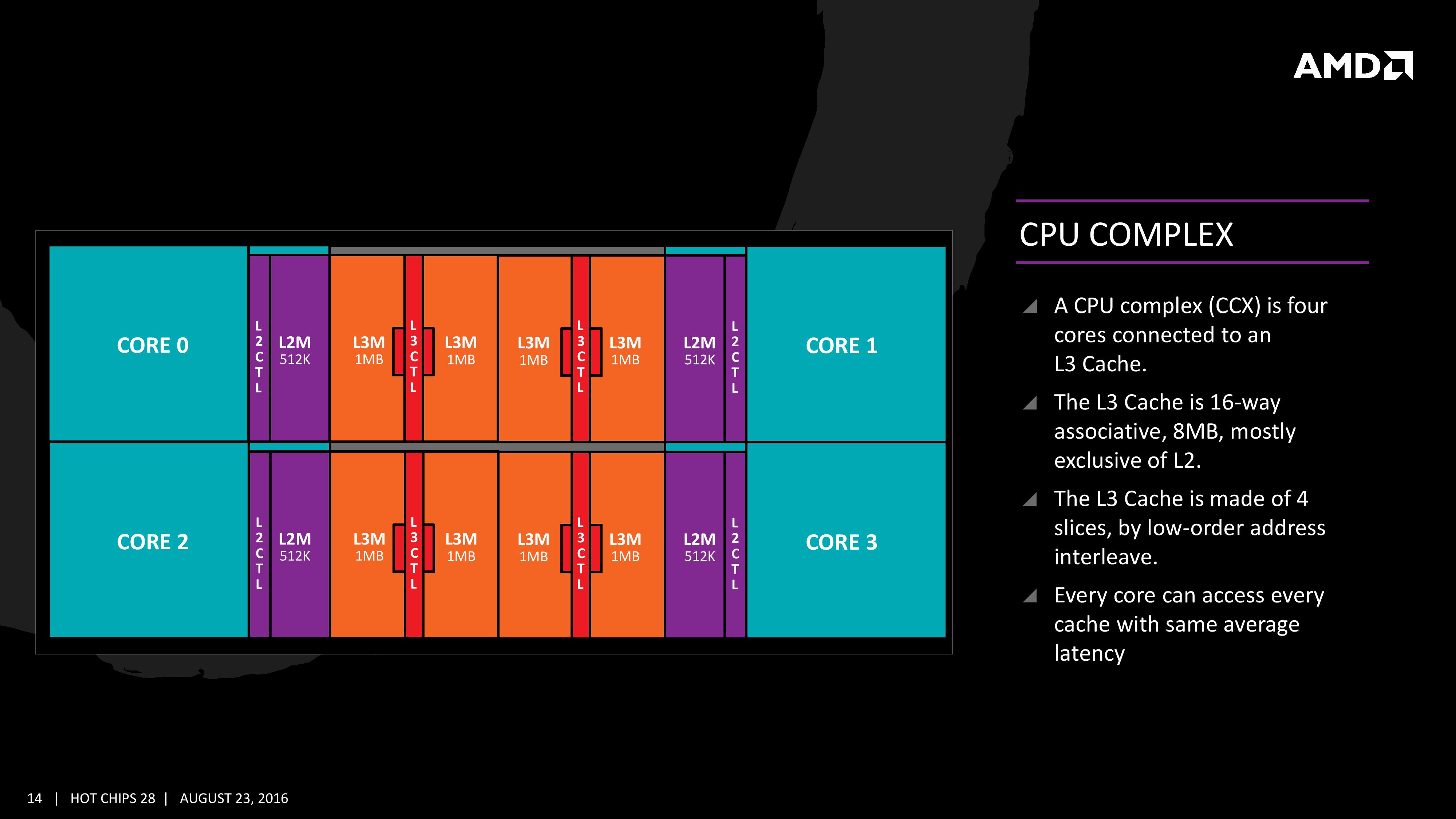AMD Zen Microarchiture Part 2: Extracting Instruction-Level Parallelism
by Ian Cutress on August 23, 2016 8:45 PM EST- Posted in
- CPUs
- AMD
- x86
- Zen
- Microarchitecture

Hot Chips is an annual conference that allows semiconductor companies to present their latest and greatest ideas or forthcoming products in an academic-style environment, and is predominantly aimed as the professional semiconductor engineer. This year has a number of talks about power management, upcoming IBM CPUs, upcoming Intel CPUs, upcoming NVIDIA SoCs and the final talk of the final day is from AMD, discussing Zen in even more depth than the previous week. While we were unable to attend the event in person, we managed to get some hands on time with information and put questions to Mike Clark, AMD Senior Fellow and design engineer.
What We Learned Last Week: L1/L2/L3 Caches and the Micro-Op Buffer
In AMD’s initial presentation for the general media, we were given a sense of the microarchitecture layout. We covered the material, but it contained a number of highlights.
AMD Zen Microarchitecture: Dual Schedulers, Micro-op Cache and Memory Hierarchy Revealed
AMD Server CPUs and Motherboard Analysis
Unpacking AMD's Zen Benchmark: Is Zen actually 2% Faster than Broadwell?
First up, and the most important, was the announcement of the inclusion of a micro-op cache. This allows for instructions that are frequently used to be closer to the micro-op queue and saves a trip through the core and caches to load the desired information. Typically micro-op caches are still relatively small, and while AMD isn’t giving any information for size and accessibility, we know that Intel’s version can support 1536 uOps with 8-way associativity; we expect AMD’s to be similar though there are many options in play.
Secondly is the cache structure. We were given details for the L1, L2 and L3 cache sizes, along with associativity, to compare it to former microarchitectures as well as Intel’s offering.
| CPU Cache Comparison | |||||
| Zen HEDT |
Bulldozer HEDT |
Excavator |
Skylake | Broadwell HEDT |
|
| L1-I | 64KB/core | 64KB/module | 96KB/module | 32KB/core | 32KB/core |
| 4-way | 2-way | 3-way | 8-way | 8-way | |
| L1-D | 32KB/core | 16KB/thread | 32KB/thread | 32KB/core | 32KB/core |
| 8-way | 4-way | 8-way | 8-way | 8-way | |
| L2 | 512KB/core | 1MB/thread | 512KB/thread | 256KB/core | 256KB/core |
| 8-way | 16-way | 16-way | 4-way | 8-way | |
| L3 | 2MB/core | 1MB/thread | - | >2MB/core | 1.5-3MB/core |
| 16-way | 64-way | - | 16-way | 16/20-way | |
| L3 Type | Victim | Victim | - | Write-back | Write-back |
In this case, AMD has given Zen a 64KB L1 Instruction cache per core with 4-way associativity, with a lop-sided 32KB L1 Data cache per core with 8-way associativity. The size and accessibility determines how frequently a cache line is missed, and it is typically a trade-off for die area and power (larger caches require more die area, more associativity usually costs power). The instruction cache, per cycle, can afford a 32byte fetch while the data cache allows for 2x 16-byte loads and one 16-byte store per cycle. AMD stated that allowing two D-cache loads per cycle is more representative of the most workloads that end up with more loads than stores.
The L2 is a large 512 KB, 8-way cache per core. This is double the size of Intel’s 256 KB 4-way cache in Skylake or 256 KB 8-way cache in Broadwell. Typically doubling the cache size affords a 1.414 (square root of 2) better chance of a cache hit, reducing the need to go further out to find data, but comes at the expense of die area. This will have a big impact on a lot of performance metrics, and AMD is promoting faster cache-to-cache transfers than previous generations. Both the L1 and L2 caches are write-back caches, improving over the L1 write-through cache in Bulldozer.
The L3 cache is an 8MB 16-way cache, although at the time last week it was not specified over how many cores this was. From the data release today, we can confirm rumors that this 8 MB cache is split over a four-core module, affording 2 MB of L3 cache per core or 16 MB of L3 cache for the whole 8-core Zen CPU. These two 8 MB caches are separate, so act as a last-level cache per 4-core module with the appropriate hooks into the other L3 to determine if data is needed. As part of the talk today we also learned that the L3 is a pure victim cache for L1/L2 victims, rather than a cache for prefetch/demand data, which tempers the expectations a little but the large L2 will make up for this. We’ll discuss it as part of today’s announcement.
The mid-week release also gave insight into the dual schedulers, one for INT and another for FP, which is different to Intel’s joint scheduler/buffer implementation. The talk at Hot Chips goes into detail about how the dispatch and schedulers operate
The New Information
As part of the Hot Chips presentation, AMD is reaffirming its commitment to at least +40% IPC improvement over Excavator. This has specifically been listed as a throughput goal at an equivalent energy per cycle, resulting in an increase in efficiency. Obviously a number of benefits come from moving the 28nm TSMC process to GloFo’s 14nm FinFET process which is used via a Samsung licence. Both the smaller node and FinFET improvements have been well documented so we won’t go over them here, but AMD is stating that Zen is much more than this as a direct improvement to immediate performance, not just efficiency. While Zen is initially a high-performance x86 core at heart, it is designed to scale all the way from notebooks to supercomputers, or from where the Cat cores (such as Jaguar and Puma) were all the way up to the old Opterons and beyond, all with at least +40% IPC.
The first immediate image out of the presentation is the CPU Complex (a CCX), which shows the Zen core design as a four-CPU cluster with caches. This shows the L2/L3 cache breakdown, and also confirms 2MB of L3 per core with 8 MB of L3 per CCX. It also states that the L3 is mostly exclusive of the L2 cache, which stems from the L3 cache as a victim cache for L2 data. AMD is stating that the protocols involved in the L3 cache design allow each core to access the L3 of each other core with an average (but a range) of latencies.
Over the next few pages, we’ll go through the slides. They detail more information about the application of Simultaneous Multithreading (SMT), New Instructions, the size of various queues and buffers, the back-end of the design, the front-end of the design, fetch, decode, execute, load/store and retire segments.














106 Comments
View All Comments
tipoo - Wednesday, August 31, 2016 - link
Bulldozers engineering samples were 2.5GHz and that shipped stupid high clocked. Zen ESs being 3GHz doesn't worry me.Cooe - Thursday, May 6, 2021 - link
Holy CRAP did history ever make you look like an absolute freaking idiot! xDextide - Monday, August 29, 2016 - link
Well, they have already shown an 8-core Zen running at full load at 3Ghz with their regular OEM heatsink/fans, and those are rated at 125W TDP max, so we do already know that's possible.defter - Wednesday, August 24, 2016 - link
It's 40% IPC improvement, not 40% overall improvement. If you improve IPC by 40% and achieve 85% of the clock speed, the total improvement will be only 20%.Since AMD hasn't talked about clock speed we can assume that it will be lower than Bulldozer.
euskalzabe - Wednesday, August 24, 2016 - link
Let me fix that for you: "Since AMD hasn't talked about clock speed we can assume..." absolutely nothing and can only wait until the final product is released.retrospooty - Wednesday, August 24, 2016 - link
Actually he is right and probably understating it. If AMD says it qill have 40% IPC improvement, it is probably not true, or true only in a few select benchmarks. If AMD left out the clockspeed it is almost definitely going to lower. AMD has zero credibility with pre-release performance claims. Nothing AMD says can be takes at its word until retail units (not engineering samples) are independently tested.Azix - Wednesday, August 24, 2016 - link
why the flying fork would the clock speed be lower? I hope you dont mean lower than they have shown, that would make no sense.Bulldozer engineering samples were maybe 2.5Ghz or 3Ghz. Additionally, talking about actual clock speeds would be to give away sku information. How they plan to structure the product line etc.
Outlander_04 - Thursday, August 25, 2016 - link
Both intel Broadwell-e and Zen were at 3 Ghz for the comparison .Broadwell-e maxes out at 3.6 Ghz , but most models are at 3.2 Ghz .
Dont let your prejudices cause you to jump to conclusions.
Zen could easily be released running at higher clock rates
silverblue - Wednesday, August 24, 2016 - link
Imagine for a second that Zen was clocked like the FX-8320E, that is a 3.2GHz base with 4.0GHz boost. Would a 40 to 50% average IPC boost make Zen competitive?For all we know, Zen could be conservatively clocked, paving the way for Zen+ with moderate tweaks and increased clocks; a bit like Piledriver vs. Bulldozer, as opposed to Phenom II vs. Phenom.
looncraz - Wednesday, August 24, 2016 - link
Zen will clock very close to 4Ghz out of the box - AMD kept most of the speed-demon elements of Bulldozer, such as the long pipelines. They also used dedicated, simple, schedulers - which is where frequency limits are frequently found... and they also put the L3 cache on a different clock bus, meaning it might operate at a different frequency from the cores... again.The engineering samples are always clocked low, so if they are running at 3Ghz for a demo, then they will be able to achieve at least 3.4~3.6Ghz, with 4Ghz boost clocks on eight-core CPUs. Quad core units will obviously go higher, still. That is why half the cores still has 70% of the power draw - it's operating higher up the frequency curve. 3.8Ghz base, 4.2Ghz boost for the top quad core SKU seems very likely given what is known.